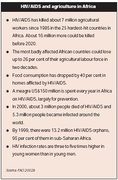Diseases and development challenges in Africa
Contents
- 1 Introduction Africa is endowed with enough land to undertake small- and large-scale activities to strengthen household security, national development, transboundary cooperation and regional integration to transform trade, and create new opportunities for sustainable development (Diseases and development challenges in Africa) which is sensitive to the environment and social and economic issues. There are, however, many threats and challenges which continue to undermine such progress, limiting its potential. These include pandemics such as HIV/AIDS, climate variability and change, extreme weather events such as drought and floods, ineffective land-use planning, land degradation and desertification, invasive alien species (IAS), limited or weak governance systems, corruption and greed, armed conflict and the attendant overexploitation of natural resources, and limited foreign direct investment (FDI). Limited domestic investment and wasted opportunities and loss of revenue due to leakage in sectors such as tourism are also important factors.
- 2 HIV/AIDS pandemic
- 3 Other diseases
- 4 Further reading
Introduction Africa is endowed with enough land to undertake small- and large-scale activities to strengthen household security, national development, transboundary cooperation and regional integration to transform trade, and create new opportunities for sustainable development (Diseases and development challenges in Africa) which is sensitive to the environment and social and economic issues. There are, however, many threats and challenges which continue to undermine such progress, limiting its potential. These include pandemics such as HIV/AIDS, climate variability and change, extreme weather events such as drought and floods, ineffective land-use planning, land degradation and desertification, invasive alien species (IAS), limited or weak governance systems, corruption and greed, armed conflict and the attendant overexploitation of natural resources, and limited foreign direct investment (FDI). Limited domestic investment and wasted opportunities and loss of revenue due to leakage in sectors such as tourism are also important factors.
HIV/AIDS pandemic
 HIV/AIDS and agriculture in Africa.
HIV/AIDS and agriculture in Africa.(Source: FA0 2002)
One of the biggest threats to Africa’s capacity to implement the necessary response measures to derive the most benefits from the opportunities available in terms of land is the HIV/AIDS pandemic. About 70 percent of the world’s 42 million people with HIV/AIDS are in Africa, the region most impacted by the pandemic. More than 25 million Africans have so far succumbed to the pandemic and more than 12 million children have been orphaned. The tragedy is that the very human resources upon whom Africa should depend to convert its land resources into opportunities for sustainable development are being buried in millions every year. About 2.3 million Africans – men and women, and most of them in the prime of their lives as parents and workers – die each year.
No economic sector in Africa is spared, and this is Africa’s greatest tragedy of the 21st century which threatens sustainable development in the region.
Other diseases
Malaria, water-borne diseases, tuberculosis, childhood diseases, tropical diseases, and respiratory and nutrition-related diseases are also significant contributors to death. All diseases affect well-being and labor productivity – some fundamentally undercut production systems
The tsetse fly is a major threat to people and livestock. About 60 million people in the region are at risk from Human African Trypanosomiasis (HAT), or sleeping sickness, which is spread by the tsetse. Sleeping sickness is found in 36 countries in sub-Saharan Africa. Between 300,000-500,000 cases are reported annually, and it kills about 66,000 people annually. The WHO/Special Programme for Research and Training in Tropical Diseases (TDR) reports that although 55 million people are exposed to the risk of infection, only 4 million are under regular surveillance, and the disease has re-emerged since the 1970s. In 2002, there were 24,000 deaths from trypanosomiasis. Authorities often lack, or do not have, adequate economic resources to fund programs to control sleeping sickness due to competing health priorities. Governments often accord sleeping sickness a low priority, until it assumes the level of an epidemic. In some countries, sleeping sickness is a major cause of death. In some areas of Angola, the Democratic Republic of the Congo (DRC) and southern Sudan, its prevalence is between 20 and 50 percent, surpassing that of HIV/AIDS.
About 46 million cattle are at risk of contracting tsetse-transmitted trypanosomiasis in Africa. About 3 million cattle die of Animal African Trypanosomiasis (AAT) annually. In the tsetse-infested areas, trypanosomiasis reduces meat and milk production by at least 50 percent. It also limits opportunities for farmers in terms of crop and livestock production: there is less efficient nutrient cycling, less access to animal traction, lower income from milk and meat sales and less access to liquid capital. The economic losses in cattle production alone are between US$1,000 and 1,200 million annually, while total losses, in terms of agricultural gross domestic product (GDP) in Africa, amount to about US$4,750,000 million per year.
Further reading
- Food and Agriculture Organization of the United Nations (FAO)
- TDR/Scientific Working Group, 2003. Report on African trypanosomiasis (sleeping sickness). Report of the Scientific Working Group Meeting on African trypanosomiasis. Geneva, 4-8 June 2001. World Health Organization, Geneva.
- UNEP, 2006. Africa Environment Outlook 2
- World Bank (undated). AIDS Regional Update: Africa. World Bank, Washington, D.C.
- WHO, 2004. World Health Report 2004: Changing History. World Health Organization, Geneva.
- WHO/TDR, 2002. African trypanosomiasis: Disease Information. World Health Organization/Special Programme for Research and Training in Tropical Diseases.
- WHO/TDR and Trends in Parasitology, 2002. African Trypanosomiasis Poster.
|
|
| Disclaimer: This article is taken wholly from, or contains information that was originally published by, the United Nations Environment Programme. Topic editors and authors for the Encyclopedia of Earth may have edited its content or added new information. The use of information from the United Nations Environment Programme should not be construed as support for or endorsement by that organization for any new information added by EoE personnel, or for any editing of the original content. |